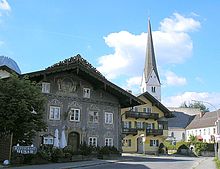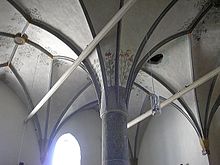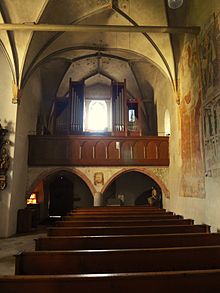Old Parish Church of St. Martin (Garmisch-Partenkirchen)
The old parish church of St. Martin (Garmisch) was once the only parish church and thus the mother church for the entire upper Loisach - and Isar valley . The outwardly simple Romanesque-Gothic church contains extensive remains of Gothic wall paintings in its interior.
Building history
The first church in Garmisch , first mentioned in a document in 802 , probably dates back to Merovingian times. Their patron is St. Martin, the most important saint in the Franconian Empire. For a long time it was probably just a simple wooden structure that had to give way to a new stone building in the Romanesque era . In 1288 it was first recorded as a parish church. Around this time the church was torn down and replaced by an early Gothic stone building. Remains of it can still be found today on the north wall of the nave and on the tower. In the course of the further building history, the old parish church of St. Martin received a west gallery in 1446, and the tower was also integrated into the building. In 1462 the church was extended to the east and a presbytery was added. With the new construction of the south wall and the late Gothic vaulting of the previously flat-roofed nave in 1520/22, the largest renovations were completed.
In the 18th century the church had long since become too small for the community. It was therefore decided to build a new baroque building elsewhere. The New Parish Church was built by Joseph Schmuzer between 1730 and 1734 and today forms the center of the Garmisch district. The Gothic church moved to the outskirts and would even have been torn down had it not been used as a hayloft. In 1877 some wall paintings were discovered in the choir, but they were painted over again. By 1915, the frescoes in the nave of the church were gradually discovered. It was not until 1958 that a large-figure representation of Saint Martin from the late fourteenth century was found on the east wall, one of the oldest and central paintings in the old church. The precious frescoes were cleaned and restored between 1990 and 2000.
description
The outwardly simple sacral building with its high, pointed helmeted Gothic tower is now a bit out of the way on the outskirts of Garmisch. The neo-Gothic girls' school from 1852/54 is built on to the southeast. The modern Lourdes grotto was placed on the southwest side of the former entrance portal. Today's access is from the west and leads under a vaulted, two-bay gallery into the nave. The interior is divided into two naves by a late Gothic reticulated vault on a central column . In the north wall of the nave, three original late Romanesque window openings have been preserved; in the south, two large late Gothic windows break through the masonry. The wide choir arch was subsequently broken out of the east wall of the rectangular, three-bay nave (13.20 × 17 m) and leads into the two-bay presbytery. The choir room (length 11 m) only reaches two thirds of the vault height of the lay room, but also has late Gothic reticulated vaults.
Mural
On the north-west side of the nave opposite the former main entrance is the - about 7 m high - representation of St. Christophorus (around 1330) preserved. Like the other paintings, the upper part of the saint was affected by the vaulting of the originally flat-roofed nave. To the east, the Passion of Jesus (around 1400) follows in 14 smaller and larger representations. The multi-figure scenes partially overlap in perspective. In addition, the pictures of Popes Urban and Gregor enthroned , Regensburg Bishop Erhard and others can be found on this wall . On the right, an “Anna Selbdritt” completes the cycle. The early renaissance work is signed "Paul Taeber 1523". The upper part of the east wall is dominated by the late Gothic representation of the "Twelve Apostles" (around 1430). The whole figures stand between arcades. This painting is also disturbed by the later bulge in the middle and on the edges. Christ as the judge of the world is enthroned above the choir arch. To the right of the presbytery, the “ Last Judgment ” is shown in a drastic way on a narrow strip (around 1430). Underneath, “Saint Martin” shares his cloak with the beggar. The large-format scene dates from the 13th century and is reminiscent of the miniatures in the “ Codex Manesse ” at the same time . Below is another late Gothic crucifixion with assistance figures. Above under the vault, the coat of arms of the Freising Bishop Philipp (1499–1541) documents the affiliation to the County of Werdenfels . On the left side of the wall you can see the "Resurrection of the Dead", next to it "Saint George" fights with the dragon.
The choir paintings (1462) were uncovered in 1893 and revised by the painter L. von Kramer , who did not always orientate himself exactly on the historical inventory. Next to the mercy seat there is the Freising diocese patrons Korbinian and Sigismund and a protective cloak Madonna. The buttresses drawn inwards are painted with depictions of saints and a "Anna Selbdritt".
The net vault of the nave is decorated with floral motifs and partly rests on figural consoles.
The recovered Garmisch wall paintings belong to one of the most complete and important cycles of medieval South German wall paintings. There are only a few places comparable to this in southern Bavaria, such as Urschalling am Chiemsee or Schleching (Streichenkapelle). Such representations are to be interpreted as "poor bibles", which should convey the contents of the Holy Scriptures to the uneducated population.
Furnishing
The high baroque high altar is a two-column work by the Kistler ( carpenter ) Thomas Ziegler and the sculptor Johannes Schenk (1669). The altarpiece by the Innsbruck painter Johannes Hartwig has been lost; a Baroque Pietà has been erected in its place since the 18th century. The former southern, simultaneous side altar was moved to the western tower wall, as otherwise it would cover the exposed wall paintings. The former left side altar was given to the Munich Nikolaikirche (Gasteig) in 1959. In the choir windows there are some Gothic glass paintings from around 1400. In addition to the Annunciation, two of the “Three Wise Men” can be seen, and another pane shows Saints Anton and Leonhard . Some grave stones from the 16th and 17th centuries are embedded in the walls.
organ
The organ was built in 2000 by Orgelbau Vleugels from Hardheim . The instrument is based on the classic Italian organ building and is not only suitable for reproducing Italian organ literature, but also especially for performing South German works. Characteristic is the low wind pressure of 48 mm wind column, which ensures an elegant and mild sound. The slider chest instrument with mechanical performance and stop action comprises a total of 16 stops on two manuals and pedal . The disposition is as follows:
|
|
|
||||||||||||||||||||||||||||||||||||||||||||||||||||||||||||
- Coupling : II / I, I / P, II / P
- Effect register : Rosignoli, tremolo , tamburo
Bells
On July 20, 2012, three new bells from the Grassmayr bell foundry from Innsbruck were consecrated . These replaced chilled cast iron bells from the post-war period that were in need of repair . Today's bells in detail:
| No. | Surname | Casting year | Caster | Weight [kg] | Diameter [cm] | Chime | inscription |
|---|---|---|---|---|---|---|---|
| 1. | St. John Nepomuk | 2012 | Johannes Grassmayr, Innsbruck | 481 | 89 | b 1 +2 | GOD IS MERCY (German translation of the name "Johannes") |
| 2. | St. Martin | 283 | 74.5 | of 2 +2 | THE SPIRIT OF GOD, THE LORD, Rests on ME; BECAUSE THE LORD HAS ANOINTED ME. ( Isa 61.1 EU ) | ||
| 3. | St. Mary | 202 | 66.5 | it 2 +1 | BLESSED, WHO BELIEVED THAT WHAT THE LORD TOLD YOU TOLD TO BE FULFILLED. ( Lk 1.45 EU ) |
literature
Old Parish Church St. Martin Garmisch (Schnell and Steiner Art Guide 12), 6th, revised edition, Munich 2008. ISBN 978-3795467678 .
Web links
- Parish of St. Martin, Garmisch: Old Garmisch Church
- Photos of the furnishings in the Old Parish Church of St. Martin, in the Warburg Institute Iconographic Database .
Individual evidence
- ↑ Garmisch, Old Church of St. Martin . Online at vleugels.de; accessed on February 24, 2017.
- ↑ Parish Association Zugspitze: The organ of the old church St. Martin ( Memento from February 24, 2017 in the Internet Archive ). Online at www.erzbistum-muenchen.de; accessed on February 24, 2017.
- ↑ Parish Association Zugspitze: Festschrift for the consecration of bells 2012 in the Old Church of St. Martin ( Memento from February 24, 2017 in the Internet Archive ). Online at www.erzbistum-muenchen.de; accessed on February 24, 2017.
Coordinates: 47 ° 29 '51.7 " N , 11 ° 5' 14.3" E









